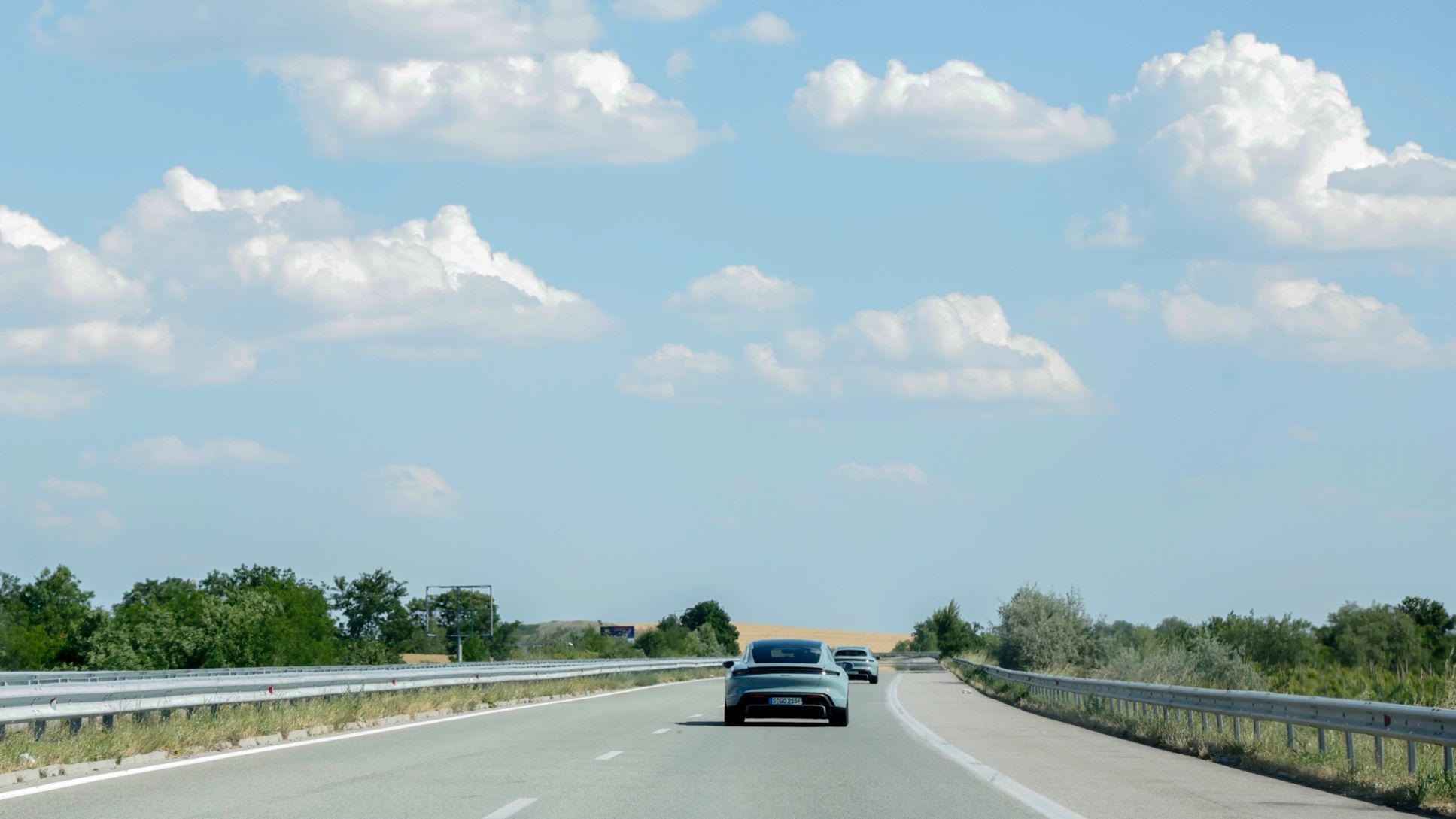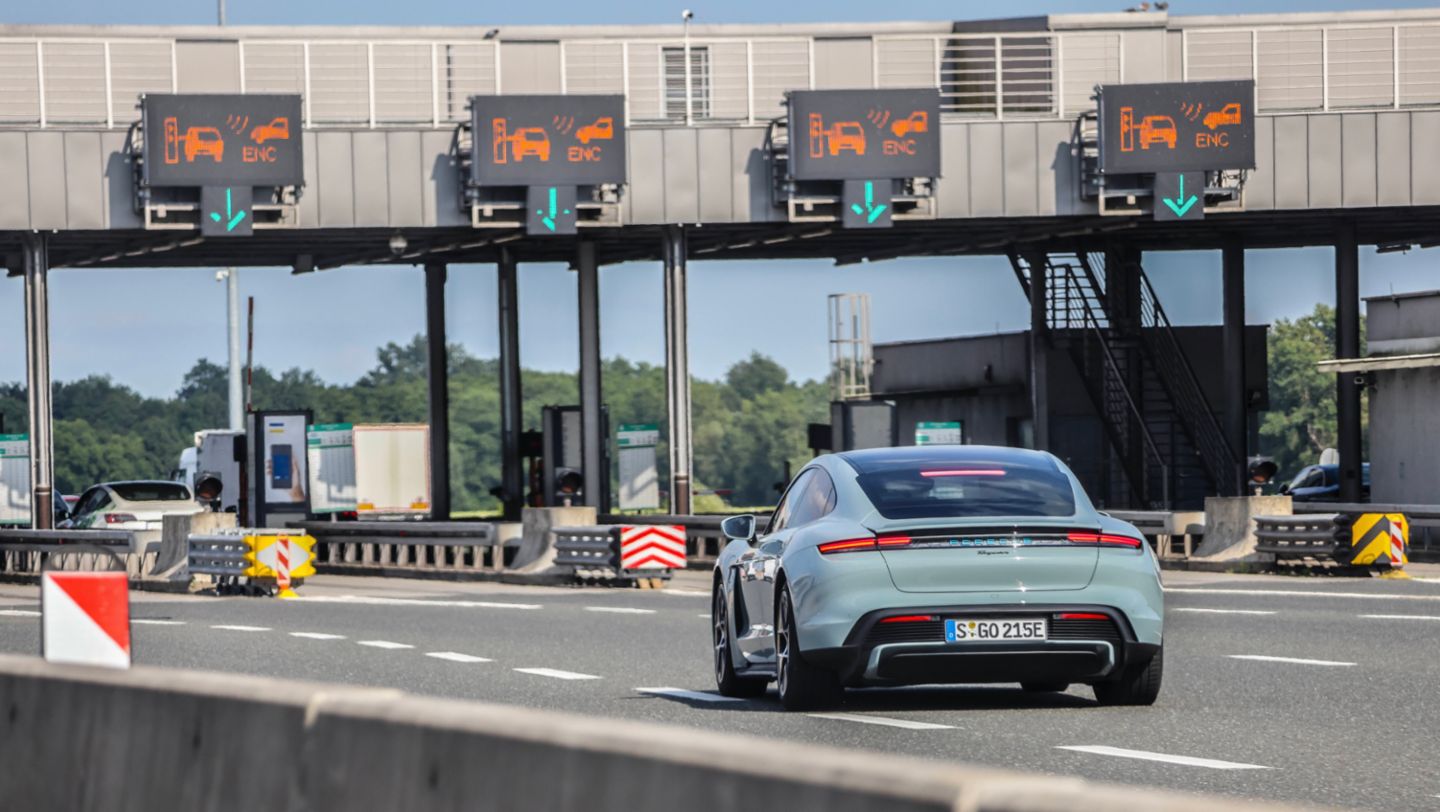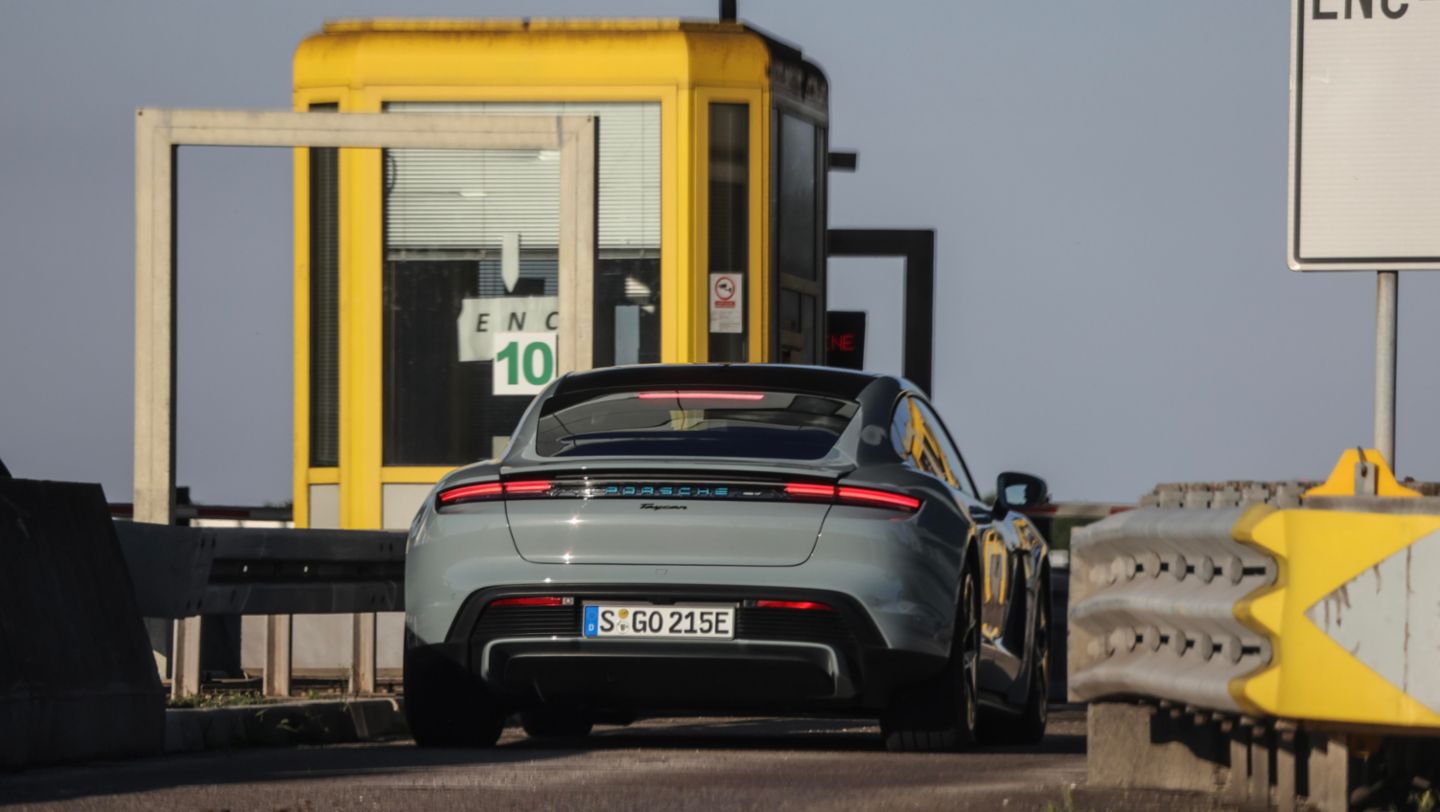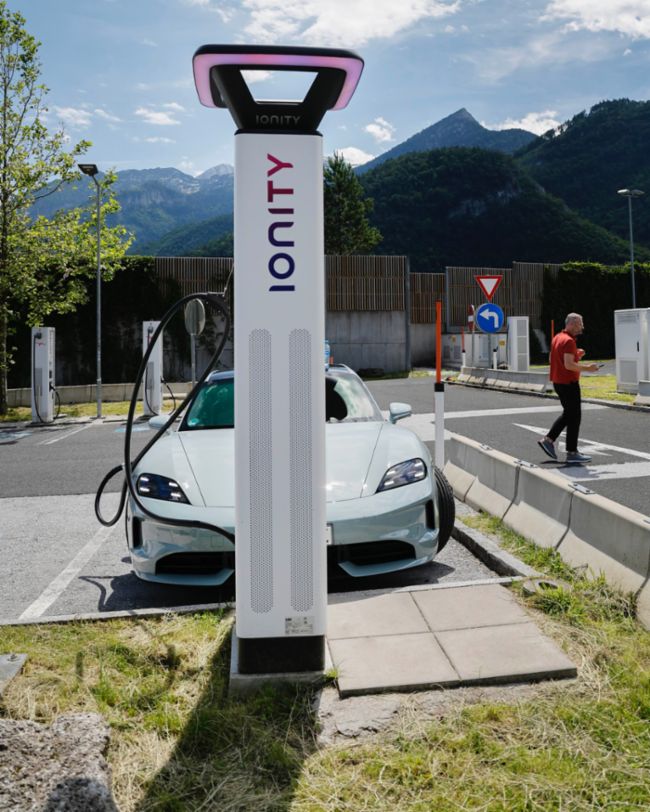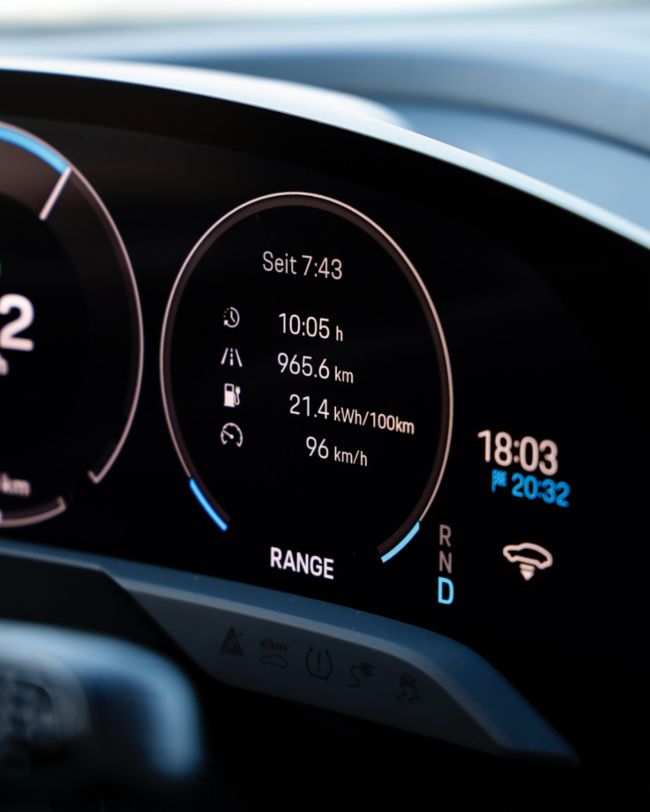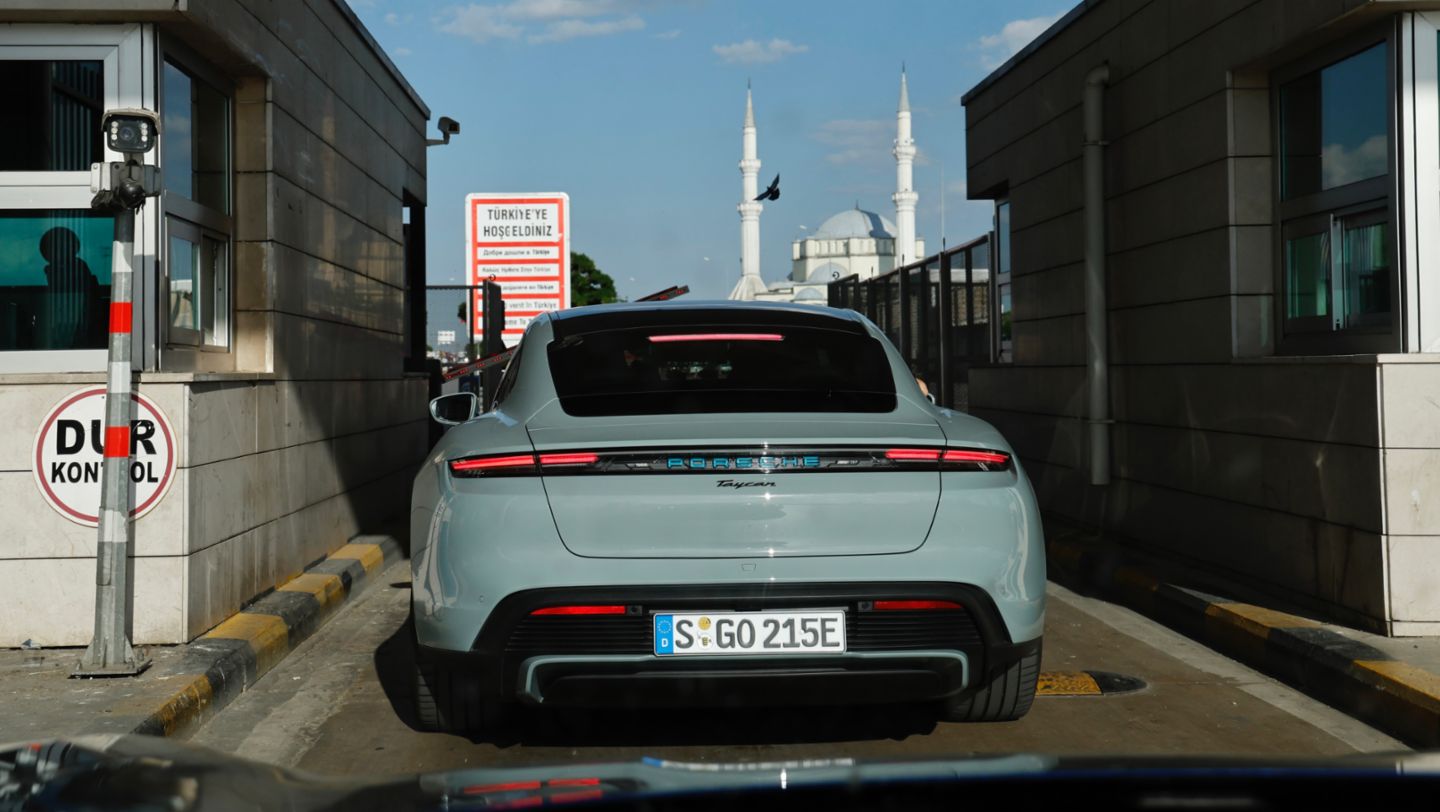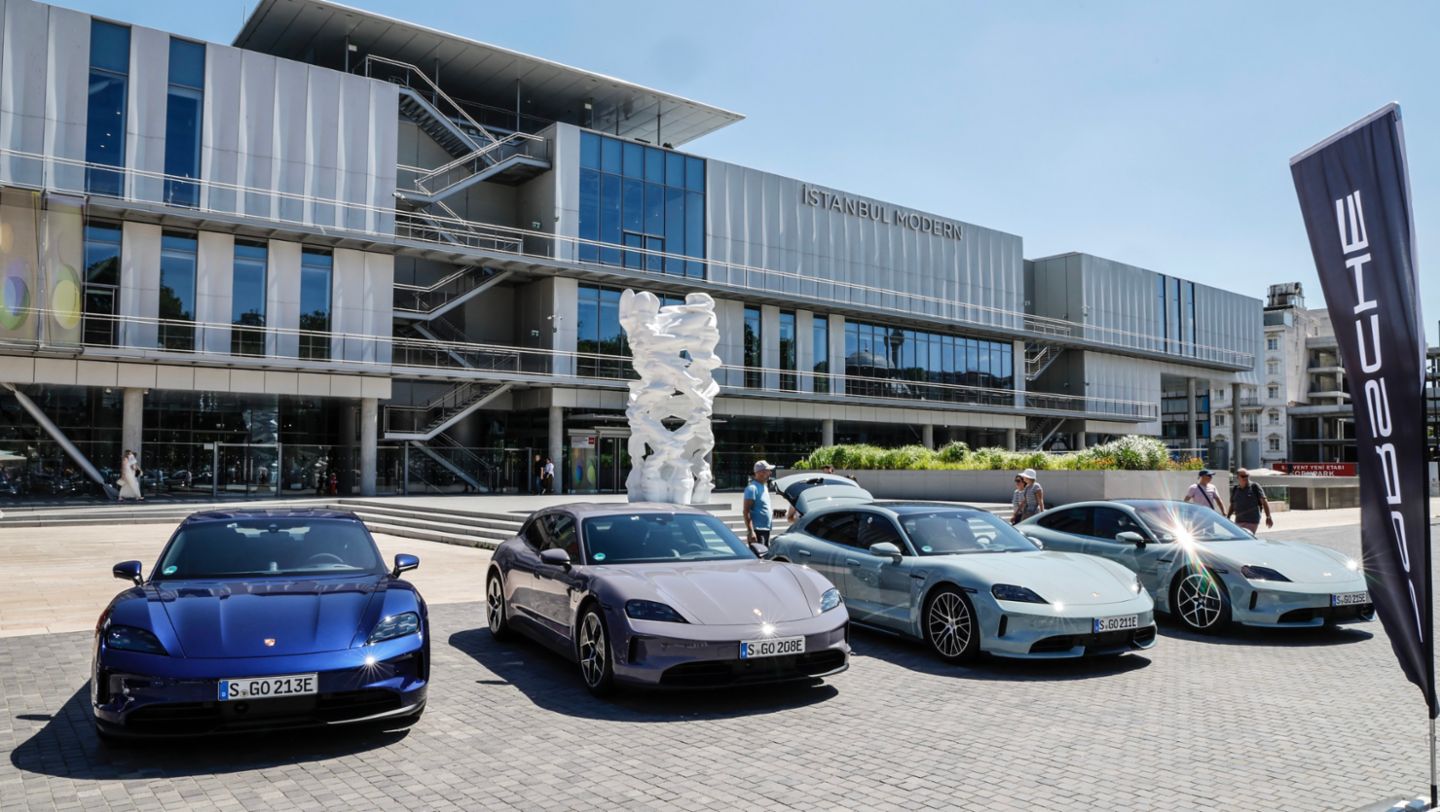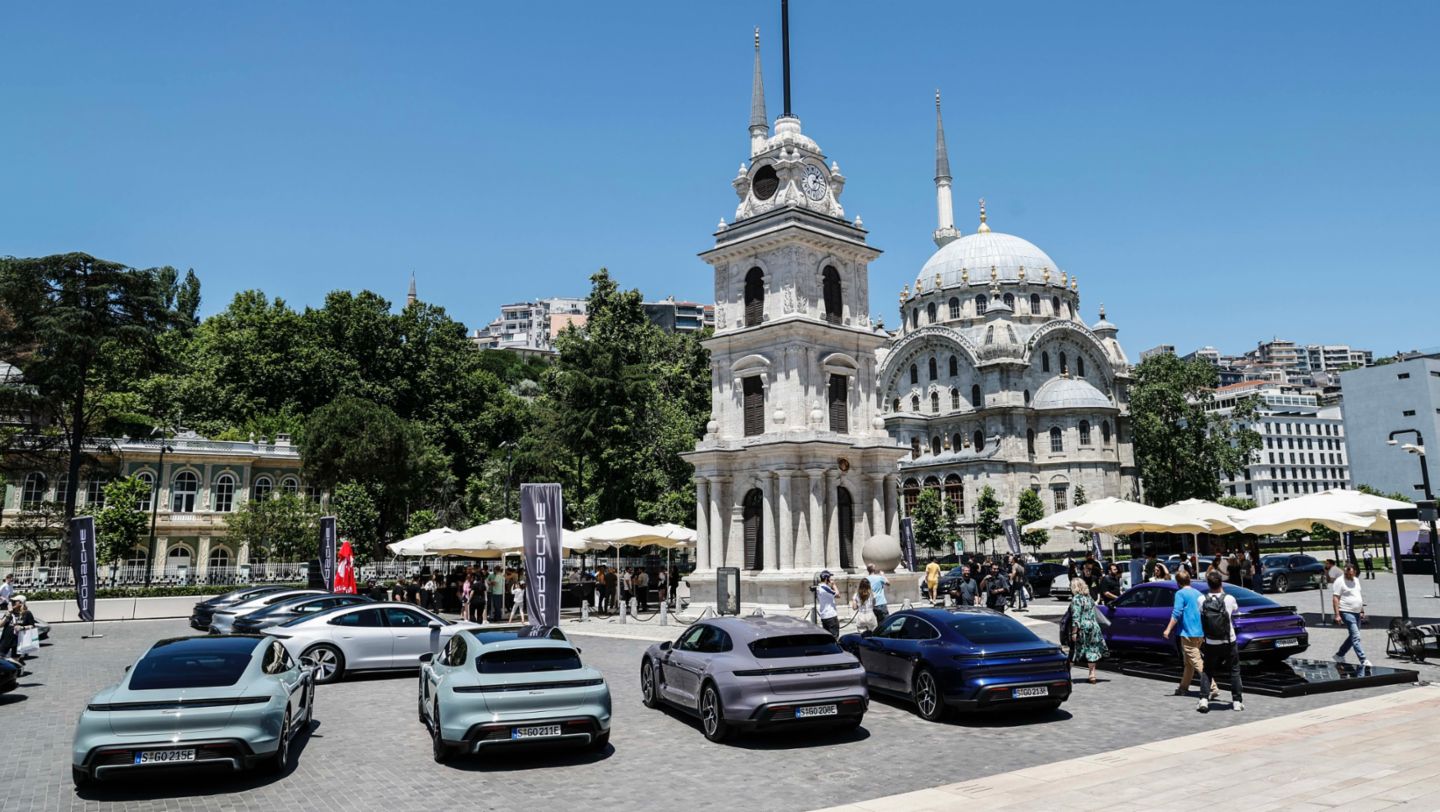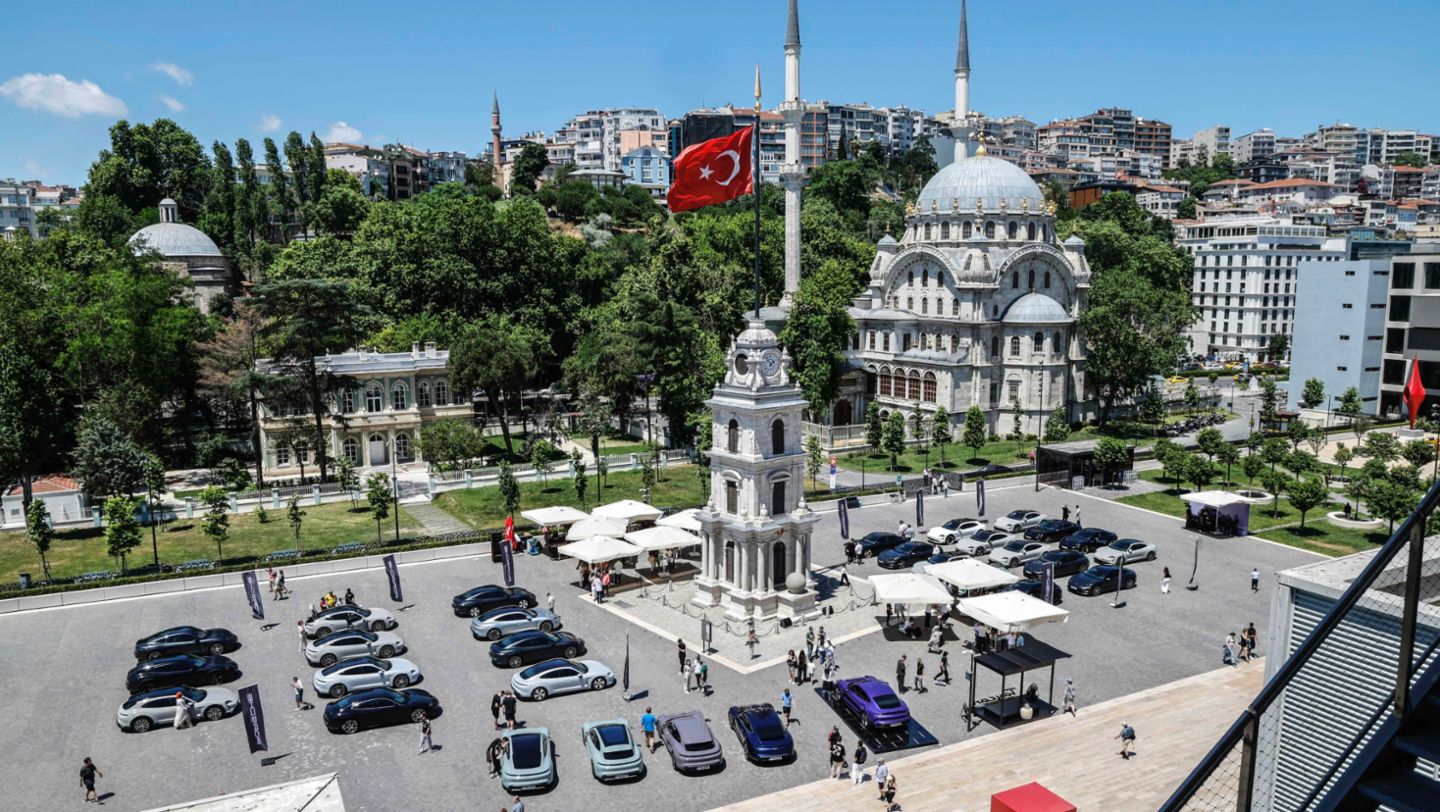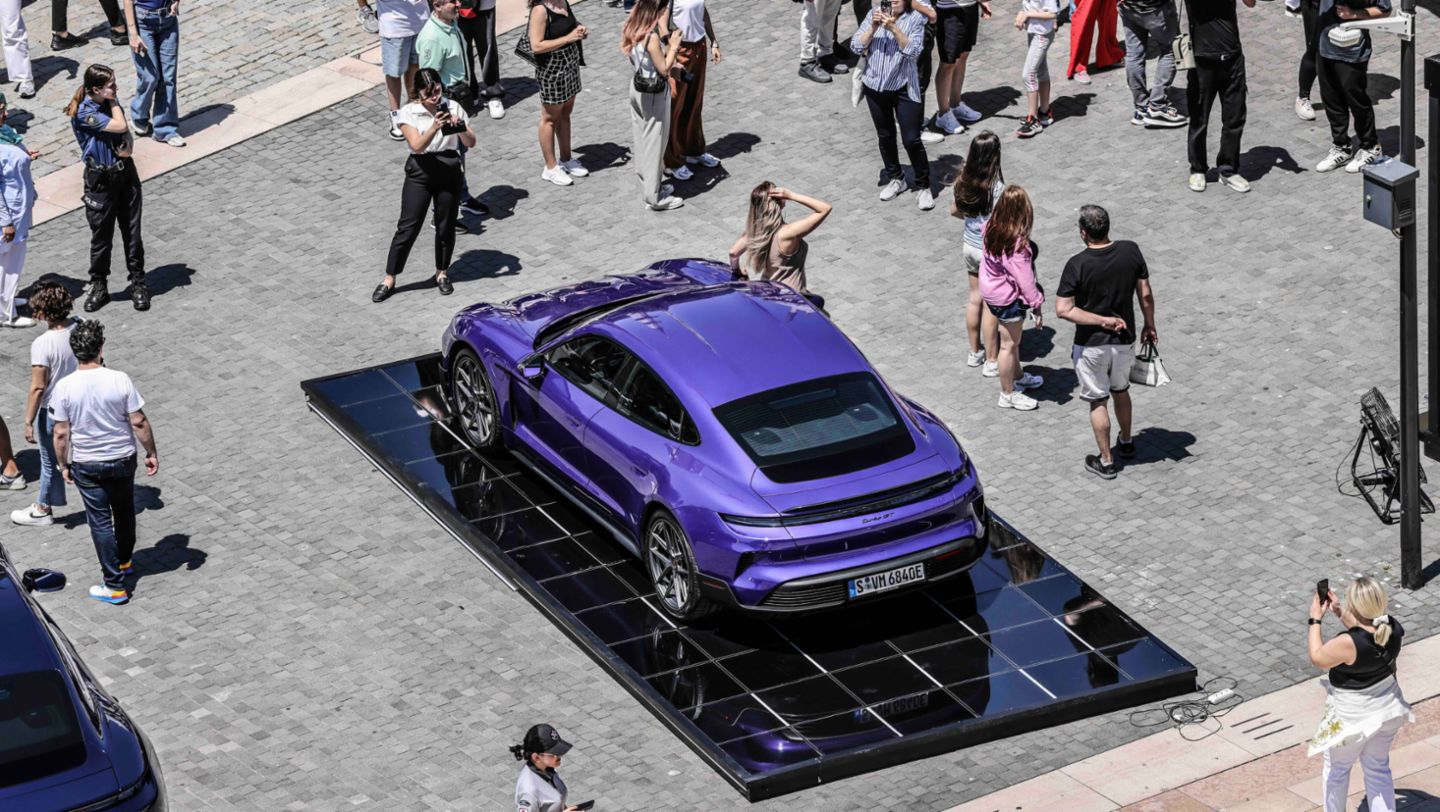It’s 08:00 on a Thursday morning at the Porsche Museum in Zuffenhausen: departure time for an almost-4,500-kilometre road trip. We head southeast, for a journey to Istanbul and back. There are seven countries to cross, plus lots of toll stations and border controls, which means inevitable queues. The test car is well equipped for the task: a new Taycan Sport Turismo with Performance Battery Plus and rear-wheel drive. It promises 320 kW (Taycan Sport Turismo with Performance Battery Plus: émissions de CO₂ en cycle mixte (WLTP) 0 g/km, consommation électrique en cycle mixte (WLTP) 20,2 – 17,8 kWh/100 km, Autonomie électrique combinée (WLTP) 570 – 651 km, Autonomie électrique en zone urbaine (WLTP) 730 – 811 km), a top speed of 230 km/h, and a WLTP range of 650 km.

There are no surprises at the start of our trip: thanks to Stuttgart's rush hour traffic it takes almost 45 minutes to get to the A8 towards Munich. There is a lot going on. We drive quickly where it is possible and permitted. Drive fast, charge fast is our strategy. The Porsche Charging Service provides access to charging points from various providers around the world. Currently, almost 700,000 charging points in 24 countries are connected in Europe. Whenever possible, we’re aiming to charge at IONITY stations.
Our first stop is the Golling West service station, 417 km away. Travel time: just under four hours. We modulate the speed so that we arrive with our battery as depleted as possible and get there with an average consumption of 22 kWh. it’s worth noting that the IONITY station is not in the direction of travel, but on the other side, however we’re able to access it via a road under the A10 motorway. Six charging stations are available and we’re able to plug straight in and begin charging. Thanks to Plug and Charge, we don't have to authenticate ourselves separately via an app or charging card. However, the charging power falters at 180 kW, suggesting something is wrong. A quick glance is enough to work out that the charging park consists of four older charge points and two newer ones. We quickly switch from old to new and the Taycan immediately starts charging at more than 300 kW. Time for a quick comfort break, and to pick up a coffee and buttered pretzel.

After 18 minutes, we’ve reached 80 per cent – normally the time to get back on the road – but as we want to make our next charging stop more than 400 km away at the southernmost IONITY charger in Croatia, we decide to keep going to more than 90 per cent before continuing our journey.
Heading south
Austria, like Stuttgart, turns out to be busy. Many campers are heading south. At the Villach junction we change from the A10 to the A11. Shortly afterwards we drive through the Karawanken tunnel, which stretches for almost eight kilometres and links Austria and Slovenia. The speed limit in the latter is 130 km/h: a good cruising speed for the Sport Turismo. We pass the capital Ljubljana on the A2 eastwards. We pay the toll online, just like in Austria, and note that the waiting times at the toll stations are short. Our next charging stop is planned for south of Zagreb. After a good eight hours of driving, we reach Sop – and the southernmost IONITY chargers. The four charging points are not located directly on the roadside, but a short detour away in a village of 350 people, next to a fuel station. Again, the charging power falters somewhat. This time at 165 kW. Since two other charging points are occupied, we don't reconnect, but instead enjoy an excellent coffee while we wait.
On such a long road trip, we can afford to lose a little bit of time. And within 18 minutes we are back at 74 per cent. Since our last leg of the day is almost 400 km again, we treat the Taycan to a few extra electrons. In Croatia, the speed limit is also 130 km/h. For the toll stations here, we organised a transponder in advance but after functioning fine at the first station it doesn’t work at the second. We pay the 16.90 euros in cash instead. Crossing the border into Serbia is much more time-consuming than the earlier crossings. The Balkan state is not yet an EU member, and this can be felt at the border, among other places. Every traveller’s passport is stamped to document their entry. From the border to our hotel in Belgrade it is just a little more than 100 km. You can pay at the toll stations either in cash or by card. The fees are low, at the equivalent of four euros. After 1,200 km and a solid 12 hours of driving, we reach our hotel in the city centre and leave the Taycan to fully charge overnight at the wallbox.

The next morning we continue early at 07:30. There are another 1,000 km to go. However, the charging infrastructure network is becoming sparser and the we’re beyond the boundary of the Porsche Charging Service. In practice, this means that charging planning still works very well, but an app or charging card from another provider is needed at each charging station. But before we get to that we enjoy the empty highways of Serbia and soak up the beautiful landscape. Since there is hardly any traffic, we can safely increase our cruising speed.
300 kW plateau charging curve compensates for congestion
In Bulgaria we return to EU territory. Having paid the toll online in advance we can enjoy the speed limit of 140 km/h. Since the highways are equally deserted here, we make very good progress and plan our first charging stop for the day in the Bulgarian capital of Sofia, 400 km from Belgrade, using the Bulgarian FINES app. We have already registered on the app in advance, and at a car dealership on the ring road to Sofia’s south, there is a 300 kW charger. A very long traffic jam in the city means it takes more than six hours to get there but the Taycan and charger compensate for this with a stable 300 kW charging ‘curve’. After just 16 minutes, the 800-volt battery is two-thirds full again, which is more than enough energy for the next 275 km to the Bulgarian border.

As if out of nowhere, the highway is suddenly jammed with traffic – not because of an accident or breakdown, but simply lots of weekend day-trippers on their way to the Black Sea coast on this Friday afternoon. No wonder at 36 degrees. Unfortunately, the beach isn’t an option for us. Instead, our next stop is at a fast charger with two connectors, next to a hotel. One is 120 kW and one is 180 kW. Here we charge to almost 90 per cent while stretching our legs and filling up on water and coffee. The last section to Istanbul is again 275 km in length and this time the motorways are empty. We make good progress and reach our final destination: after a total of almost 2,200 km and a good 25 hours, we’re in Istanbul.
Istanbul – Belgrade – Sop - Ljubljana – Zuffenhausen
The next morning, at the city’s modern Galata Port, we join a Taycan Meet and Greet that we’ve organised together with Porsche Turkey. Some 25 cars turn up, and we’re there with our four new Taycans, a Taycan Turbo GT and a new electric Macan. The mood is good, the music loud. Many passers-by take the opportunity to look at the latest models and take a selfie. There are around 2,000 Taycan sports cars on the road in Turkey, such is its popularity here.
On Monday morning we begin our journey home – back to Stuttgart via Belgrade. The first stage is 250 km long and as we don't have enough ‘in the tank’ to drive all the way to Sofia, we make a six-minute ‘splash and dash’ stop on the highway at a 150 kW charger. Unfortunately, it’s on the other side of the road and it takes time to get there.
At around 13:30 we arrive at a 300 kW charger next to a large car dealership. We charge from nine to 81 per cent in just 20 minutes. The charging performance means we can overlook the fact that, unlike other charging locations in this area, there is no toilet or café. With the final 400 km of the day under way, we head from Bulgaria back to Serbia. The traffic is much better than on the outward journey and we make good progress. The temperature rises again to up to 37 degrees but the Taycan runs like clockwork. The heat doesn't bother this all-electric sports car. In Lapovo we pause to refresh ourselves. The Charge & GO charger only delivers 100 kW, but it’s still a completely sufficient rate to charge at on a long journey. After 18 minutes, the journey continues. Comfortable and fast, it takes us less than 12 hours to cover the almost 1,000 km to our destination in Belgrade. At the hotel we charge the car for free. We end the evening relaxing on the roof terrace.

Problem-free charging stop thanks to Plug and Charge
At 7:00 the following morning, we set off, with 1,200 km on the day’s schedule. The batteries of the driver, passenger and car are all nicely topped up and we leave the Serbian capital via the Danube to the north. The speed limit is 130 km/h. Since there is hardly any traffic, the average speed is not much lower. Our first charging stop is an old acquaintance: the same roadside IONITY charger in Sop, Croatia, that we visited on our way south. Thanks to Plug and Charge, the charging process starts without any problems, and we recharge more than 82 kWh within 21 minutes.
Shortly after 09:00, we are back on the road, heading for Slovenia and then on to Austria. The further north we get, the lower the temperature gets. It also starts to rain a little. We pass the Slovenian capital Ljubljana and take in the magnificent landscape. Towards Austria we have some hills to climb. About 330 km after our last stop, we reach the IONITY charging station in Eisentratten. Here, it takes us 19 minutes to recharge more than 81 kWh – a record for us. There is hardly any time to talk to the Taycan driver next to us, and we set off, with just 500 km left to go. Around Munich, a traffic jam spoils even higher average speeds. After that, the motorway gets quieter and the Taycan can once again show us what it is made of. One last, eight-minute stop in Jettingen-Scheppach is enough to reach our final destination: the Porsche Museum in Zuffenhausen.
What a road trip! We’ve completed almost 4,400 km with an average consumption of less than 23 kWh. Since we were able to charge for free in the hotels we stayed in, the charging costs amount to less than 250 euros. Proof that the Taycan is not only sporty and comfortable, but also economical.
